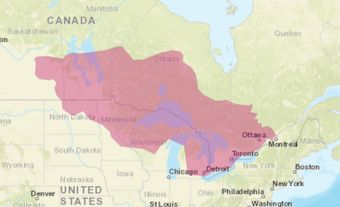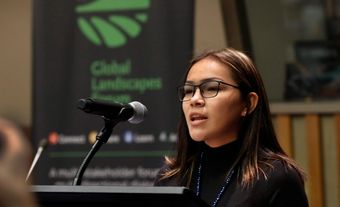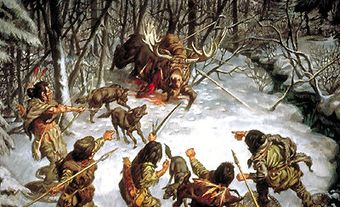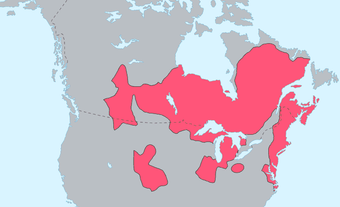Nipissing (also Nbisiing) First Nation people are of Algonquin and Ojibwe descent. (See also Anishinaabe and Algonquian.) The First Nation is made up of several communities along the north shore of Lake Nipissing. Their motto is an affirmation for protection of A-Kii (land), Bemaadzijik (people) and E-Niigaanwang (future). Nipissing First Nation was the first Anishinaabe nation in Ontario to ratify their own constitution in 2014. The population of Nipissing First Nation, as of November 2020, is 2,909. Two-thirds of the population reside off-reserve, while 916 live on-reserve.

Territory
Nbisiing territory is known in Anishinaabemowin (the Anishinaabe language) as Nbisiing E-Wiijidgbenmang Gete Naadziwin Gda Kiimaan. Archaeological studies confirm the Nbisiing territory has been occupied for at least 9,000 years.
The traditional territory ceded under the Robinson Huron Treaty of 1850 covers 26,530 km2. Nbisiing rights of use on their territory are protected under this treaty. (See also Treaties with Indigenous Peoples in Canada.)
Nipissing Indian Reserve No. 10 is the Nbisiing Shkon’gan. Shkon’gan translates to lands leftover from traditional territory. Land appropriations in the mid-1800s resulted in the Nbisiing land base to reduce significantly. Through negotiation with the Crown, the land base is presently 210 km2. It is located immediately west of North Bay, Ontario.
The First Nation protects the natural areas around Lake Nipissing. In 2003, the Nipissing Land Code, enacted under the First Nations Land Management Act, provides for self-governance over the land and waters of the Nbisiing.
Did You Know?
Natural medicines are found across Nbisiing territory. Traditionally, the Nbisiing have conducted ceremonies for the preparation of these medicines, such as by the Midewiwin. These ceremonies may have led early French missionaries and Huron-Wendat people to erroneously describe the Nbisiing as sorcerers in their accounts.
Early History
In 1615, Samuel de Champlain encountered the Nbisiing at Lake Nipissing. European records, like the Jesuit Relations, described Nbisiing people as commercially astute, and a society bound in principles of solidarity, equality and liberty.
The Nbisiing had a strong influence as traders. Known as the Nipissing Passageway, regional trade routes formed a junction in Nbisiing territory at Lake Nipissing. This afforded the Nbisiing participation in a vast continental trade network. Fish, furs and canoes were exported to other First Nations, such as the Cree, Kanyen'kehà:ka (Mohawk) and Huron-Wendat, for corn, tobacco and other goods. The Nbisiing also traded with the French and English. In exchange for furs, the Nbisiing received cloth and blankets, guns and metal goods. (See also Fur Trade in Canada.)
Increasing competition for furs brought on the Beaver Wars (or Iroquois Wars), a series of 17th-century conflicts between the French, the English and their respective Indigenous allies. After these conflicts, the Nbisiing retreated geographically and returned to Lake Nipissing in 1671.
The Nbissing have also fought in other colonial wars. During the Seven Years’ War, in 1756, 80 Nipissing were part of the expedition on Fort Edward under Louis-Joseph de Montcalm. The Nbissing also took up arms in the War of 1812 and are veterans of wars in the 20th and 21st centuries. (See also First Nations and Métis Peoples in the War of 1812 and Indigenous Peoples and the World Wars.)
Did You Know?
Traditionally, doodems or clans were important to Nbisiing social structure. They designated groups based on lineage, affirmed alliances and were used to select the chief. Prior to the Indian Act of 1867, Nbisiing headmen selected their chief as a part of the Feast of the Dead. Chief Michel Shabogesic may have been the last chief affirmed at such a gathering. Nbisiing today equate the Deer as their logo and identify their doodems as Heron, Eagle, Red Tail Hawk, Beaver, Loon, Bear, Marten, Moose, Hawk, Fish, and Wolf.
Politics and Governance
Political selection of the Eniigaanziwaand (council) is conducted every third year in accordance with the Nipissing First Nation Custom Election Code. In 2014, the Nbisiing enacted the Gichi Naaknigewin (Constitution.) Nipissing First Nation was the first Anishinaabe nation in Ontario to ratify a constitution.
Nbisiing voted to adopt the Anishinabek Nation Governance Agreement, a proposal for self-government, in 2021. This agreement recognizes the Nbisiing’s authority in citizenship, leadership selection, language and culture, and management and operations. The agreement was signed with the federal government in 2022.
Under the Anishinabek Education System, the Nbisiing enjoy control of on-reserve education. The Nbisiing Secondary School is in Duchesnay Village. (See also Education of Indigenous Peoples in Canada.)
Employment and Commerce
Nipissing First Nation is involved in various business ventures. This includes Bineshii Business Park (a multi-tenant office building), the Duchesnay Creek Bridge project, and the Solar Power Network Partnership. Nbisiing entrepreneurs and commercial leases provide employment opportunities through their individual business ventures.

Arts and Culture
The Nbisiing people create art in various mediums, such as painting, carving, wrought iron design, performance art, writing, digital media and illustration. Traditional artisanal work continues in loom and bead work, quill, leather, fur dressing and deer hide tanning.
Aanmitaagzi, an Indigenous and artist-operated studio, is based on Nipissing First Nation. Aanmitaagzi’s commitment is to foster “a vibrant arts community through community-engaged projects that promote well-being, strengthen relationships with the land, and incorporate intergenerational approaches and methodologies.” (See also Contemporary Indigenous Art in Canada.)


 Share on Facebook
Share on Facebook Share on X
Share on X Share by Email
Share by Email Share on Google Classroom
Share on Google Classroom








